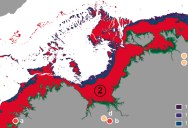New Data Shows That Sunken Parts Of Australia’s Coast Could Have Supported Massive Numbers Of Humans

We talk a lot about space being the last frontier but for me, the ocean has always felt as if it holds more than its fair share of mysteries.
And all of the time, researchers are proving me right as they use developing technology to “see” deeper underwater than ever before.
For the first time, scientists are getting a different look at a huge swathe of land that, 70,000 years ago, a bunch of humans called home.
It was so large, in fact, that they think it likely played a huge role in migration from Indonesia to Australia.
Kasih Norman, lead author and archaeologist, talked with Live Science about their findings.
“We’re talking about a landscape that’s quite submerged, over 100 meters below sea level today. It comprised a large stretch of continental shelf that, when above sea level, would have connected the regions of Kimberley and Arnhem Land, which today are separated by a large ocean bay.”

It once helped form the palaeo continent that connected Australia, New Guinea, and Tasmania into one single unit called Sahul.
Until now, though, there’s been little research into whether or not the sunken part could have been inhabitable by humans.
“There’s been an underlying assumption in Australia that our continental margins were probably unproductive and weren’t really used by people, despite the fact that we have evidence from many pats of the world that people were definitely out on these continental shelves in the past.”
Norman’s new study meshes regional data with detailed maps of the seafloor, provided by sonar mapping by ships. That sonar mapping showed that the conditions on that shelf changed drastically over time.
It showed that between 71,000 and 59,000 years ago, sea levels were about 130 feet lower than they are now, putting the outer northwestern edge of the Australian continent within reach of the Southeast Asian island of Timor.
Between 29,000 and 14,000 years ago sea levels dipped again, exposing an even larger landmass – a continental shelf – right beside modern-day Australia that was “about 1.6 times the size of the UK.”
They believe this would have made it easier for humans to migrate.
“It would have meant that there was basically a contiguous archipelago environment to move from the Indonesian archipelago, across to Sahul, and then from that archipelago into the supercontinent itself. This could have enabled a staged migration between modern-day Indonesia and Australia.”
The sonar mapping also revealed a tall, sheltering escarpment containing an inland sea and freshwater lake. That, along with several river beds, would have made an ideal place for humans to dwell.
A lot of people, Norman thinks – maybe up to a half a million.
“It’s important to bear in mind these aren’t real population numbers we’re talking about, it’s just a matter of projecting the carrying capacity of our landscape. We’re basically saying it could have had that many people.”
Other research, though, indicates that hundreds of thousands of people might actually have called it home – at least until rising tides forced them away.
The last ice age ended around 14,000-14,500 years ago, causing seal levels to rise quickly over the course of 100 years.
“In this 400 year period, over 100,000 square kilometers of land go underwater. People would have really seen the landscape change in front of them, and been pushed back ahead of that encroaching coastline quite rapidly.”
This study, published in Nature, analyzed the genetics of people living in the Tiwi Islands, which are on the edge of the sunken shelf today. They show that around the same time, at the end of the last ice age, the area had an influx of new residents.

Norman hopes her research, along with other papers, will force everyone to pay closer attention to the important role the shelf might have played in Australian – and world – history.
“It’s quite fascinating to look at how people dynamically responded to events in the past and obviously survived them and thrived. I would hope that there might be something we can take from that, that we can apply to future climate change and sea level rise in the next few hundred years.”
Everything old is new again.
There is something comforting about knowing humans who have gone before us faced some of the same challenge but learned to adapt – and in time, even thrive.
If you think that’s impressive, check out this story about a “goldmine” of lithium that was found in the U.S. that could completely change the EV battery game.

Sign up to get our BEST stories of the week straight to your inbox.




